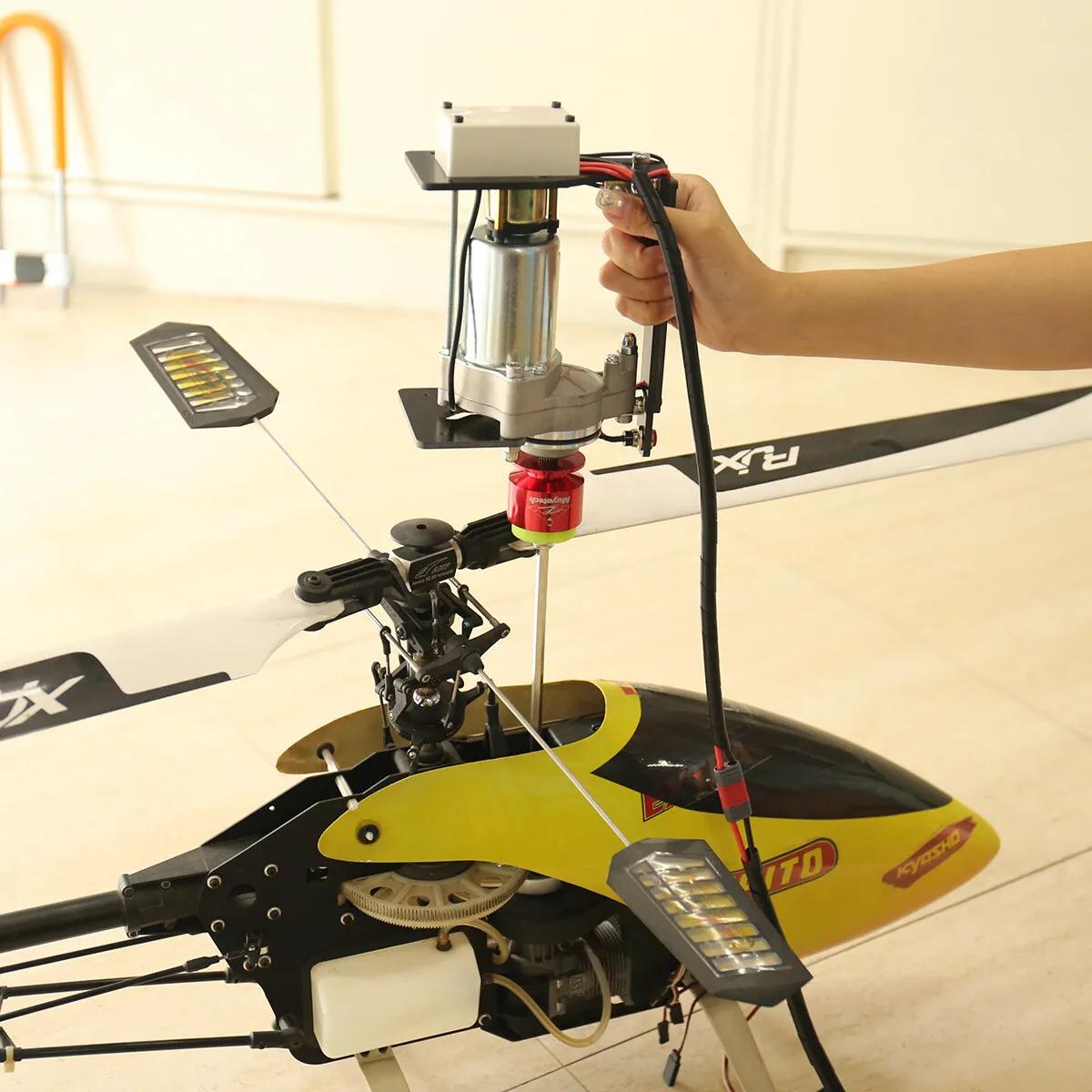Gas-Powered Remote Helicopters: Features, Engines, Price, Safety Tips, and Maintenance.
A gas-powered remote helicopter is one of the most popular remote-controlled toys in the market. These types of helicopters use gasoline as their fuel source rather than electric power. Gas-powered helicopters are commonly used for aerial photography, remote surveillance, and rescue missions. Gas-powered remote helicopters have a longer flight time compared to electric-powered helicopters. They are also able to fly longer distances and carry a heavier load. Most gas-powered remote helicopters have a more stable flight performance, making them ideal for professional use. These helicopters also require less maintenance than electric-powered helicopters.
Benefits of Gas-Powered Remote Helicopters
Gas-powered remote helicopters have a longer flight time compared to electric-powered helicopters, making them ideal for various professional and recreational activities. Here are some features of gas-powered remote helicopters:
- Longer flight times than electric-powered helicopters
- Ability to fly longer distances
- Ability to carry a heavier load
- More stable flight performance
- Less maintenance required than electric-powered helicopters
Several brands and models of gas-powered remote helicopters are available in the market, including Align, Blade, and Synergy. It is crucial to buy from a reputable seller to ensure that the product is genuine, and spare parts are readily available. Some websites offer reviews and comparison guides to assist buyers in choosing the best gas-powered remote helicopter for their needs.
What are some recommended brands of gas-powered remote helicopters and how can buyers ensure they are purchasing a genuine product?
Some recommended brands of gas-powered remote helicopters are Hirobo, Bergen R/C, and Century Helicopter Products. Buyers can ensure they are purchasing a genuine product by checking for authorized dealerships, looking for quality packaging and materials, and consulting online reviews and forums for reliable feedback.
Gas-Powered Remote Helicopter: Facts, Speed, Lifespan, and Comparison Table
The gas-powered remote helicopter has an internal combustion engine similar to full-size helicopters. Here are some interesting facts about the engine:
- Started by a pull-starter, unlike electric-powered helicopters that require a battery to be charged
- Produces a specific type of flying sound and a gas smell that can be quite appealing to some hobbyists
- Can achieve speeds of up to 180 km/h (112 mph) in some models
- Generally has a lifespan of up to 15 years with proper care and maintenance
Here is a table comparing the specifications of two popular gas-powered remote helicopter models:
| Model | Flight Time | Distance | Payload | Price |
|---|---|---|---|---|
| Align T-REX 700XN | 12-15 minutes | 800m-1km (0.5-0.6 miles) | 5-6 kg (11-13 lbs) | $1,099.99 |
| Synergy N7 | 15-18 minutes | 550-600m (0.34-0.37 miles) | 3 kg (6.6 lbs) | $819.99 |
Some websites offer detailed reviews and comparison guides for different gas-powered remote helicopter models. It is essential to research the various options available in the market before making a purchase decision.
What are some websites that offer reviews and comparison guides for gas-powered remote helicopter models?
Some websites that offer reviews and comparison guides for gas-powered remote helicopter models include RC Helicopter Fun, RC Groups, and Heliguy.
Factors to Consider When Pricing a Gas-Powered Remote Helicopter
The price of a gas-powered remote helicopter varies depending on the model, size, and features. Here are some factors to consider when it comes to pricing:
Brand: Well-known brands may cost more than less popular ones.
Fuel type: Some gas types may cost more than others depending on their availability and refinement process.
Complexity: Different features, such as a dual rotor setup, autopilot module, or a better camera, can add up to the final price of the model.
Various websites offer price comparison tools and reviews of different models that can help customers make informed decisions. Additionally, some websites provide options for purchasing gas-powered remote helicopters. It is essential to check the warranty policy and return policy before making a purchase. Shipping time and cost are other factors to consider.
What factors affect the price of a gas-powered remote helicopter?
The factors that affect the price of a gas-powered remote helicopter are its brand, size, features, power, and quality of materials used.
Important Safety Tips for Gas-Powered RC Helicopters
When operating a gas-powered remote helicopter, it’s crucial to follow safety guidelines to avoid accidents and injuries. Here are some safety tips to keep in mind:
- Ensure that the helicopter is operating in an area that is designated for aerial activity.
- Protect your eyes and hands by wearing gloves and goggles.
- Keep the helicopter at a safe distance from people and objects to avoid collisions and unwanted contact.
- Never operate the helicopter near an airport or any aircraft landing areas as it could interfere with the flight path of planes.
- Avoid operating the helicopter during extreme weather conditions such as high winds, rain, or snow.
- Always operate the helicopter with caution and keep an eye on its position.
It is crucial to read the instruction manual thoroughly before operating the gas-powered remote helicopter. Several websites provide tips and guidelines for safe operation. Additionally, various online forums or groups are dedicated to discussions about remote-controlled helicopters, and professionals and hobbyists can share their experiences and offer expert advice on safe operation.
What are some additional resources for learning about safe operation of gas-powered remote helicopters?
Online forums and instructional videos produced by manufacturers or experienced remote helicopter pilots are additional resources that can provide guidance and knowledge on safe operation of gas-powered remote helicopters.
Essentials of Gas-Powered Remote Helicopter Maintenance
Proper maintenance is essential for the longevity and safe operation of gas-powered remote helicopters. Here are some maintenance tips:
- Regularly clean the helicopter to prevent dirt and dust accumulation that could potentially interfere with flight.
- Check the fuel line for blockages and clear any obstructions to ensure smooth operation.
- Change the spark plug and oil regularly to prevent engine damage and ensure optimal performance.
- Store the helicopter in a cool and dry place to prevent corrosion of metal parts.
- Replace worn out or damaged parts immediately to prevent further damage to the helicopter.
- Keep spare parts readily available to repair any damages promptly.
Several websites and forums provide tips and guidelines for maintaining gas-powered remote helicopters. Users can also find replacement parts and accessories on these sites. It’s crucial to invest in high-quality parts to ensure the safe and efficient operation of the helicopter.
What are some websites that provide maintenance tips and replacement parts for gas-powered remote helicopters?
Some websites that provide maintenance tips and replacement parts for gas-powered remote helicopters are HeliFreak, RCGroups, and Horizon Hobby.
Conclusion
Gas-powered remote helicopters are an excellent choice for hobbyists and professionals who require longer flight times and greater payload capabilities. While they require less maintenance than electric-powered helicopters, proper care is essential for safe and efficient operation. Regular cleaning, checking the fuel line for blockages, changing spark plugs and oil, and proper storage are all essential maintenance steps to ensure the longevity of your gas-powered remote helicopter.
There are numerous websites and forums that provide tips on how to maintain and repair gas-powered remote helicopters, and most importantly, investing in high-quality replacement parts is crucial for optimal performance. Although the cost of purchasing a gas-powered remote helicopter can be more than that of an electric-powered one, the longer lifespan and greater capabilities make it well worth the investment for serious hobbyists or operators who require specialized equipment.
Whether used for photography, remote surveillance, or rescue missions, gas-powered remote helicopters are reliable and adaptable tools that can help operators achieve their objectives. By following safety guidelines and ensuring proper maintenance, gas-powered remote helicopters can provide years of trouble-free operation.








